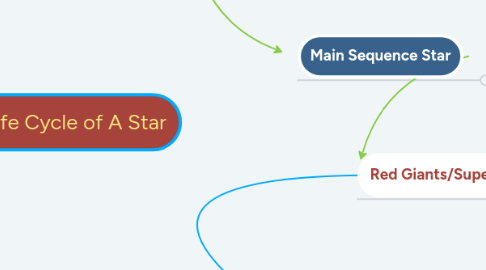
1. Black Dwarfs
1.1. The white dwarfs fade out, go cold and become black dwarfs
2. Protostar
2.1. Particles in the clouds of dust and gas in space are pulled together by their own gravitational attraction and speed up. The clouds merge and become a protostar.
2.1.1. As a protostar gets more dense, the particles speed up and the temperature increases.
2.1.1.1. If it gets hot enough, fusion takes place. The energy released in fusion makes the protostar even hotter and it starts to shine and becomes a star
3. Main Sequence Star
3.1. Energy at the core keeps it hot so fusion continues.
3.2. These stars can maintain their energy output for millions of years.
3.3. The star is stable due to the balanced forces of the gravity acting inwards and the radiation from fusion acting outwards. They stay in equilibrium until most of the hydrogen nuclei has fused into helium.
4. Red Giants/Supergiants
4.1. When stars around the same size and mass of our Sun run out of hydrogen, its core collapses and the outer layers swell out.
4.1.1. They then become red giants. Helium and other light elements start to fuse into heavier elements at the core.
4.2. When stars much bigger than our Sun run out of hydrogen, they swell out to red supergiants.
4.2.1. And then they collapse.
5. White Dwarfs
5.1. From red giants that have no light elements left in the core, fusion stops and no more radiation is released.
5.1.1. Due to there being no equilibrium in the forces, it collapses under its own gravity. It heats up and turns from red to white through the visible light spectrum.
5.1.1.1. This is now a white dwarf, a star much hotter and denser and smaller than before.
6. Supernova
6.1. The collapse of supergiants causes the core to be compressed more and more.
6.1.1. Then it reverses into a massive explosion called a Supernova.
6.1.1.1. Heavy elements are formed when a supernova occurs and scatters the elements across the universe. The debris around the star is known as a nebula.
7. Nebula
7.1. From a nebula, a new protostar can be formed from all the dust and gas continuing the cycle.
8. Neutron Stars and Black Holes
8.1. If the star before the explosion was big enough, a black hole is formed instead.
8.1.1. Nothing, not even light can escape a black hole due to its immense gravitational field.
